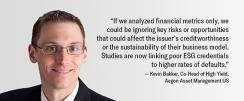On the surface, responsible investing and high-yield bonds may appear to have little in common. In an asset class fraught with lower credit ratings, potentially weaker governance models, and exposure to less environmentally friendly companies, it might seem that high yield bonds and ESG goals can’t coexist. While challenges exist, high yield and responsible investing need not be mutually exclusive. In fact, a research-intensive process can help uncover attractive ESG opportunities in junk-bondland to create a best-in-class strategy. II recently spoke with Kevin Bakker, Co-Head of High Yield, Aegon Asset Management US, to understand how investors can pursue ESG-related goals in a dedicated high yield strategy.
High-yield issuers generally aren’t thought of as the most ESG-friendly group of companies. In addition, ESG investing tends to mean different things to various asset managers. What does an ESG-based approach to high-yield investing mean to you? Are you simply excluding the bad actors?
You’re right – ESG terminology is convoluted and there are multiple flavors of responsible investing. For context, at Aegon Asset Management, we segment the responsible investing landscape into four main categories: exclusionary, best-in-class, sustainability-themed, and impact investments. Along with dedicated responsible strategies, managers may also integrate ESG factors across their traditional product set as we do.
Exclusionary strategies use negative screening to avoid the bad actors, as you mentioned. That is one approach that high-yield managers may use to weed out companies – and even entire sectors or industries – with weak ESG profiles. However, we believe there’s more value in allocating capital towards companies with strong or improving ESG profiles. In other words, selecting the “best” high-yield companies on an ESG and economic basis. What we find interesting about an ESG-based approach to high yield is that a portfolio can be tilted towards companies with solid ESG profiles, while also providing attractive investment opportunities.
To be clear, we don’t view ESG factors in isolation. It’s critical to consider the company’s financial condition, and the economics of the trade cannot be ignored. Incorporating ESG factors can help us better understand investment risk and effectively evaluate if the market is pricing that risk appropriately. After all, we’re always focused on meeting our clients’ expectations of competitive performance results.
How to do you tilt towards more favorable ESG profiles? And what differentiates a company with a strong ESG profile from one with a weak one?
To help identify good and bad ESG profiles, we categorize issuers into five buckets depending on the level of ESG-related risk. Companies with strong ESG profiles tend to have robust governance practices and are finding ways to operate in more environmentally and socially friendly ways. Further, some high-yield companies might be leaders in sustainable business practices.
For example, let’s look at a downstream aluminum producer in the metals and mining sector. On the surface, you may wonder how such a company could be environmentally friendly. But what if they supply aluminum to the auto and transport industries, supporting the shift toward more fuel-efficient vehicles and reducing greenhouse gases? What if the company is an industry leader in the sustainable production and recycling of aluminum products? Those are good sustainable business goals and practices.
If we move down the ESG spectrum, companies with improving or low-risk ESG profiles may also be attractive investment candidates. A company may not be an ESG leader today, but they might have well-articulated policies in place to mitigate most ESG risks – for example, a homebuilder that is an industry leader in product quality and safety, and is also taking advantage of green building opportunities.
On the flip side, companies with weak ESG profiles may have high governance concerns or be involved in business practices where environmental or social factors present a material risk to the company’s credit fundamentals. Consider an education loan manager and servicer that is fraught with financial product controversies tied to allegedly deceptive business practices in the servicing of student loans. If, in this example, the company also engenders corporate behavior concerns due to lawsuits claiming the company increased customers’ debt burdens, the risk related to social factors has risen to the point where ESG considerations can have a material impact on the company’s creditworthiness.
In a best-in-class approach, investment candidates must meet both our ESG and economic thresholds to be considered for the portfolio. To pursue performance-based objectives and responsible investment goals, we cannot focus exclusively on ESG without considering the economic return prospect of the underlying bond.
To conduct an assessment, it seems third-party ESG data would be important. How has the ESG data for high-yield companies evolved in recent years?
Research providers today cover more issuers than in the past, and companies are disclosing more ESG-related information. That said, methodologies are often complex and contradictory. In short, we don’t rely solely on third-party data. To obtain a holistic view of a company’s risk/reward profile, we believe it’s critical to combine internal viewpoints with external research to formulate a proprietary view on the issuer’s ESG profile and creditworthiness.
Which sectors or industries have naturally low ESG-related risks?
Consumer discretionary, financials, technology, telecom, and real estate – at a sector level. However, in a best-in-class approach, we believe it’s important to look at what companies are doing to specifically mitigate or alleviate ESG-related risks. There are companies operating in industries historically thought of as “good ESG” sectors that have significant risks. For example, traditional pharmaceutical companies are generally viewed positively for creating drugs that improve human health. However, the high-yield market has several companies that have been under pressure for following a less altruistic business model. Several high-yield issuers have been following a business model of slashing R&D and drastically increasing prices on critical drugs to boost margins. In addition, several of these same issuers are under fire for their role in the opioid crisis, including accusations of knowingly fulfilling fraudulent scripts. So, an industry viewed as having low ESG risk doesn’t necessary translate into all companies within that industry having strong ESG profiles.
Along the same lines, which sectors tend to have weak ESG profiles?
The energy sector is quite controversial from an ESG perspective. Specifically, the independent energy industry is dominated by exploration and production companies with high ESG concerns. Environmental effects of oil and gas production are numerous, and many issuers also have a history of questionable health and safety practices, as well as weak governance issues driven by founding partners and private equity involvement.
ESG concerns are also elevated in the metals and mining sector, and chemicals industry. With metals and mining, extracting minerals involves myriad environmental risks related to disturbing the natural environment. Farther downstream, smelting these materials into steel and aluminum is highly carbon intensive. From a social perspective, health and safety is a concern given the high rates of injuries and fatalities in the industry. For the chemicals industry, carbon emissions are elevated for upstream petrochemical companies. Chemical safety is more of a concern for the downstream specialty chemical businesses given the potential negative health aspects of many products.
Negative screening can help eliminate the more obvious culprits, but we believe the real value in ESG investing goes beyond basic negative screening to identify companies with better practices or improving ESG profiles. Keep in mind that not all companies within a sector are created equal, so excluding an entire sector is not a viable solution. That’s why we look for companies that have a well-articulated ESG strategy and have solid governance practices. For example, some natural gas producers may have better ESG profiles relative to oil companies. And midstream pipeline companies tend to have more efficient and safer delivery methods than transporting commodities via rail. Another example: steel production using scrap input to an EAF furnace carries a much smaller environmental footprint than a company using iron ore, met coal, and a blast furnace.
Are there potential limitations for a best-in-class approach to high-yield bond investing?
You could have a persistent bias against certain industries, such as energy, particularly if they make up a large component of the underlying index. Likewise, an ESG-based approach to high yield could result in a slight up-in-quality bias. Generally speaking, companies rated CCC or below tend to be smaller and have a greater percentage of private equity involvement. All things being equal, higher private equity involvement tends to lead to weaker governance profiles.
It’s also important to note that while the focus on stronger ESG profiles may result in a slightly more concentrated portfolio with modestly higher tracking error, ample opportunities remain to build a diversified high yield portfolio.

Let’s talk about the elephant in the room – performance. Do you expect that the positive ESG portfolio tilt will affect performance results?
We view ESG factors as a risk management tool and a potential alpha source. For many companies, we find that it’s quite challenging to analyze the future profitability without considering ESG factors. In other words, if we analyzed financial metrics only, we could be ignoring key risks or opportunities that could affect the issuer’s creditworthiness or the sustainability of their business model. Studies are now linking poor ESG credentials to higher rates of defaults. A recent study by Bank of America cited that 90% of bankruptcies in the S&P 500 between 2005 and 2015 could have been avoided if environmental and social scores were considered in the five years prior. By integrating ESG factors, we think it’s possible to identify risks under the surface that could help mitigate default losses.
Think about the basics of bond investing. At the end of the day, we are looking for opportunities to generate income plus potential capital appreciation, while selecting issuers with the highest likelihood of repaying their debt obligations. If a company’s operations are harming the environment and pose a high risk of lawsuits, don’t those environmental considerations increase your financial risk? Or let’s say a company is engaged in unfair labor practices – doesn’t that impact the longer term risks of their business model? How about a situation where corporate governance is poor – doesn’t that increase the likelihood of a company running into financial difficulties?
Simply put, we believe ESG factors can affect profitability. Companies that manage their business with those factors top-of-mind are more likely to have sustainable business models and sustainable cash flows over the long term. From that perspective, we believe companies with better ESG profiles may outperform those with weak ESG practices, resulting in ESG factors being a potential source of long-term alpha.
Learn more about the potential in high yield ESG.
Disclosure
Past performance is not indicative of future results. The information contained in this article is for informational purposes only and should not be considered investment advice or a recommendation of any particular security, sector, strategy or investment product. The article contains the current opinions of the firm and is accurate as of the date of the article. Such opinions are subject to change without notice. The firm is under no obligation, expressed or implied, to update the material contained herein.
All investments contain risk and may lose value. Socially responsible investing is qualitative and subjective by nature, and there is no guarantee that the criteria utilized, or judgment exercised by any company of Aegon Asset Management will reflect the beliefs or values of any one particular investor. There is no guarantee that socially responsible investing (SRI) products or strategies will produce returns similar to traditional investments.
Specific sectors mentioned do not represent all sectors in which Aegon AM US seeks investments. It should not be assumed that investments of securities in these sectors were or will be profitable.
Investments in high yield bonds may be subject to greater volatility than fixed income alternatives, including loss of principal and interest, as a result of the higher likelihood of default. Value of these securities may also decline when interest rates increase.
This article contains forward-looking statements which are based on the firm's beliefs, as well as on a number of assumptions concerning future events, based on information currently available, and are subject to change without notice. These statements involve certain risks, uncertainties and assumptions which are difficult to predict. Consequently, such statements cannot be guarantees of future performance and actual outcomes and returns may differ materially from statements set forth herein.
Aegon Asset Management US is a US-based SEC registered investment adviser and is also registered as a Commodity Trading Advisor (CTA) with the Commodity Futures Trading Commission (CFTC) and is a member of the National Futures Association (NFA). Aegon Asset Management US is part of Aegon Asset Management, the global investment management brand of the Aegon Group.






